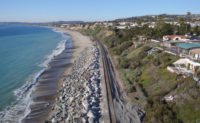Transit officials in California have awarded a contract for emergency repairs to stabilize a slipping hillside that has pushed a section of beachside railroad toward the Pacific Ocean.
Oakland, Calif.-based geotechnical contractor Condon-Johnson & Assoc. will perform emergency stabilization work along an approximately 700-ft-long section of track on the Orange County Transportation Authority-owned Orange County Line and Inland Empire-Orange County Line in San Clemente. The team is currently finalizing design and permitting, OCTA spokesperson Eric Carpenter says.
Incremental hill movement plus storm surge and sand erosion have moved the tracks as much as 28 in. over the past 13 months, according to OCTA.
The project will involve drilling 100-ft steel anchors into the bedrock of the hill above the track to prevent it from pushing the track further toward the ocean. The team has also added riprap on the coastal side of the right-of-way to secure it until the emergency stabilization work begins. The project is expected to cost about $12 million.
Area service of the Metrolink commuter rail and Amtrak Pacific Surfliner has been suspended since Sept. 29 over safety concerns. BNSF has continued to operate freight service through the area, a spokesperson says.
Officials had initially planned for a two-phase project that would have enabled passenger rail service on the heavily used line to resume as soon as November. It would have involved using temporary anchors while permanent anchors made of noncorrosive material were manufactured.
However, the contractor instead will perform the work in a single phase with noncorrosive materials, Carpenter says.
The revised timeline means passenger rail service cannot resume until mid-December at the earliest, and may have to wait until mid-January when construction is expected to finish. But the second phase of work, which had been expected to last until July 2023, will not be necessary.
Mark Murphy, OCTA chairman and Orange mayor, said in a statement that the emergency stabilization work is “uncharted territory” but that the agency would act in the interest of passenger safety.
“We want this work to get done as soon as possible but we first need to make sure it’s done right and the slope is secure,” he said.
Financing Not Yet Secured
The California Transportation Commission approved $6 million for the work during an emergency meeting Oct. 3. OCTA officials say they are working with state and federal officials to secure the rest of the funding for the project.
This section of track is part of the 351-mile LOSSAN rail corridor connecting Los Angeles to San Diego and San Luis Obispo. It is the second-busiest intercity passenger rail corridor in the U.S. with more than 8.3 million annual passengers pre-COVID-19, according to OCTA.
OCTA staff are scheduled to update the authority’s board of directors on the situation at an Oct. 24 meeting.






Post a comment to this article
Report Abusive Comment